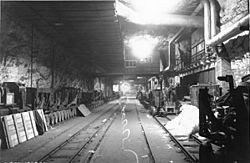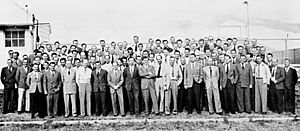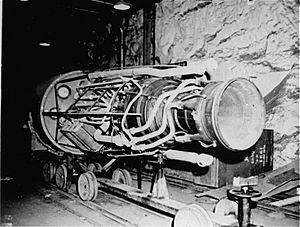Mittelwerk facts for kids
Quick facts for kids Mittelwerk |
|
|---|---|
| Nordhausen, Thuringia | |

Interior of the tunnels
|
|
| Coordinates | 51°32′05″N 10°45′04″E / 51.5348°N 10.751°E |
| Type | Underground bunker |
| Site information | |
| Open to the public |
Museum in the southern part of Tunnel A |
| Site history | |
| Built | Completed 1943 |
| Built by | Mittelwerk GmbH |
| In use | 1943–1945 |
Mittelwerk (which means "Central Works" in German) was a secret German factory built deep underground during World War II. It was located inside a mountain called the Kohnstein. The factory was designed to be safe from Allied bombing attacks.
Mittelwerk used forced labor from the nearby Mittelbau-Dora concentration camp. Thousands of prisoners were forced to work there, building powerful V-2 ballistic missiles, V-1 flying bombs, and other weapons for Germany.
Contents
Mittelwerk: A Secret Underground Factory
In August 1943, British bombers attacked the main V-2 rocket development center at Peenemünde. After this attack, Germany decided to move rocket production underground to protect it.
On October 19, 1943, a German company called Mittelwerk GmbH was given a huge contract. They were ordered to produce 12,000 A-4 missiles (which were later known as V-2 rockets). Each rocket cost 40,000 Reichsmarks.
Mittelwerk GmbH also managed other secret sites for rocket development and testing. Many engineers and scientists worked at Mittelwerk. This included Wernher von Braun, who was a key figure in rocket development. He visited the factory many times, especially during its difficult construction phase in 1943.
Other Secret Projects and Weapons

By July 1944, parts of the underground factory were also used for other projects. Some tunnels were used to build jet and piston engines for Junkers aircraft.
Between February and April 1945, the Nordhausen plant also produced Taifun anti-aircraft missiles and Heinkel He 162 jet fighters. They even started a plant to produce liquid oxygen, which was needed for the V-2 rockets. There were also plans for an underground oil plant, but it was never finished.
Production of V-1 flying bombs began in late 1944. By February 1945, Mittelwerk was the only factory still producing V-1s. A total of 2,275 V-1s were built there from September 1944 to April 1945.
While there have been rumors about other "exotic" weapons being built at Mittelwerk, there is little strong proof.
Evacuation of the Factory
In early 1945, as Allied forces advanced, there were discussions about attacking the Nordhausen plant. On April 3 and 4, 1945, British bombers attacked the area. They hit buildings that were thought to be barracks, but actually housed forced laborers. The town of Nordhausen was also hit.
The forced laborers from Mittelbau-Dora were evacuated on April 4. Scientists working at Mittelwerk were also moved to a safe area in the Alps. Despite an order from Hitler to destroy any useful infrastructure, the Nordhausen plant was evacuated without damage. This was because German officials like Albert Speer ignored the order.
After the War: Discovery and Legacy
When American troops arrived in the Nordhausen area, they were shocked by what they found. On April 11, 1945, the U.S. 3rd Armored Division and 104th Infantry Divisions reached Nordhausen. They discovered the terrible conditions at the nearby Boelcke Kaserne barracks, where many sick and dead forced laborers were found.
It's estimated that about 2,541 people were killed and 5,923 injured by V-2 rocket attacks. However, the human cost at Mittelwerk and its subcamps was much higher. Out of about 60,000 prisoners who passed through Mittelbau-Dora, an estimated 20,000 died. Many died from overwork, cold, hunger, or disease. Some were killed by guards.
Operation Paperclip: Rocket Scientists

After the war, the US Army launched "Special Mission V-2" (part of Operation Paperclip). On May 22, 1945, they shipped the first trainload of V-2 rocket parts from Mittelwerk to the United States. These parts were used for American rocket projects.
The Nordhausen area was later given to the Soviet Union as part of the post-war agreements. Soviet Army officers visited the plant on May 26, 1945. In June 1945, the US Army left the Nordhausen plant, leaving behind parts, tools, and documents for the Soviets. The Soviet Army took control of Mittelwerk on July 5, 1945. They later destroyed both entrances to the tunnel system in mid-1948.
Mittelwerk Today: Ruins and Museum
In 1995, a new entrance tunnel was dug to the former rail Tunnel A. Today, about 710 meters of the tunnel system are open to visitors. However, large parts of the system are flooded by groundwater or have collapsed.
After Germany was reunified, the tunnels were often looted by people looking for treasures. Access to the tunnels was not fully secured until 2004. An archaeologist named Willi Kramer, who explored the tunnels, estimated that 70 tons of material were stolen.
See also
 In Spanish: Mittelwerk para niños
In Spanish: Mittelwerk para niños



